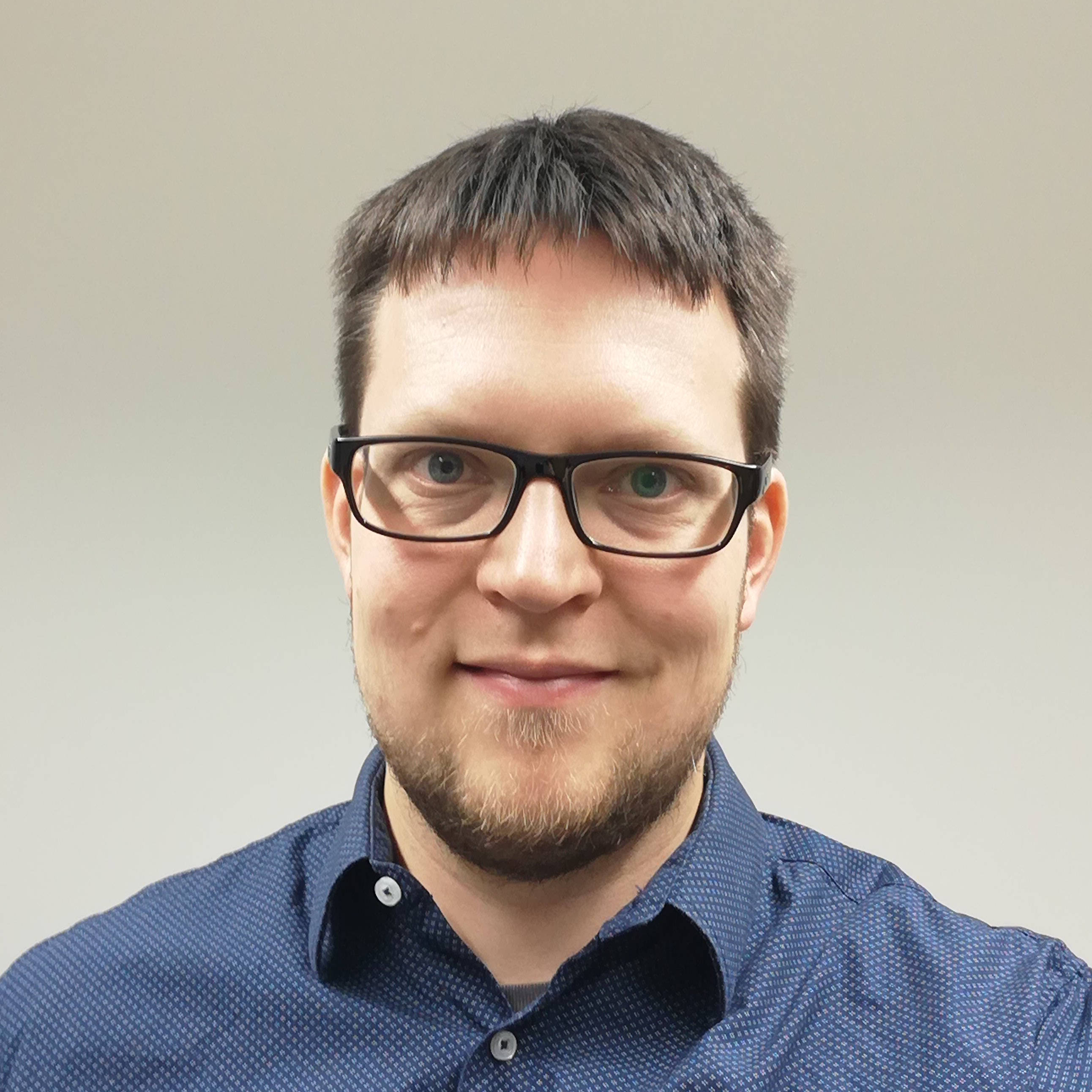Biobased Materials Structure
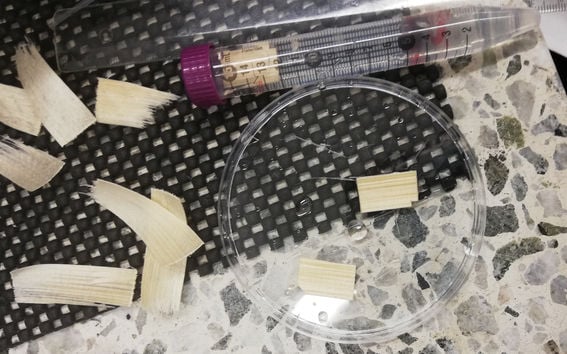
Research topics
-
Nanoscale structural characterization of biobased materials
-
Development of X-ray and neutron scattering data analysis
-
Wood nanostructure and moisture interactions
News and events
- Welcome to our new research assistant Chihiro Yamamoto!
- Our first doctoral researcher Aleksi Zitting will defend his thesis on November 15, 2024
- Group leader Paavo Penttilä received the Hayashi Jisuke award by The Cellulose Society of Japan, see news item
Ongoing research projects
Neural networks for X-ray scattering analysis of wood materials (NNxWOOD)

This Academy of Finland Research Fellow project (2021–2026) aims to develop new machine learning based methods for analysing X-ray scattering data from wood materials. A detailed picture of the structure of wood cell walls is highly desired to accelerate the development of new, sustainable applications from this abundant renewable raw material. Recently developed imaging techniques based on X-ray scattering offer unprecedented possibilities for studying the hierarchical structure of wood, but the development of new automated procedures for the data analysis is necessary.
Follow on X (Twitter): #NNxWOOD
Automatized reconstruction of wood cell wall nanostructure from X-ray scattering patterns (WoodCensus)

This collaborative project between our group and VTT Technical Research Centre of Finland is funded by the Research Council of Finland for 2024–2026. The project develops a workflow for automatized analysis of small-angle scattering data from wood materials. The method generates three-dimensional reconstructions of the cell wall nanostructure based on scattering patterns. It aims to make the use of scattering methods more efficient, to digitalize the nanostructure of wood cell walls, and to promote the utilization of high-performance computing in the field of bio-based materials.
Simulation-assisted scattering analysis of moisture-induced swelling in wood microfibril bundles (SASAMIS)
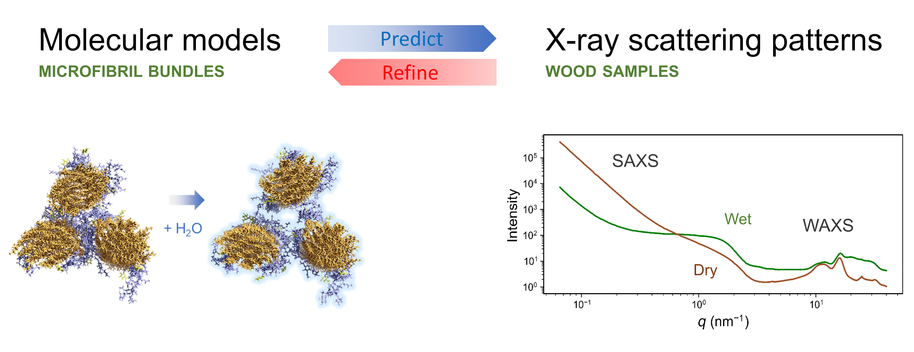
The interpretation of X-ray scattering data from wood currently depends on highly approximate models of cellulose microfibrils and their bundles. By coupling molecular simulations with tailored scattering measurements, we can improve the resolving power of both methods, and gain fundamental information on the nanoscale structure and moisture behaviour of wood. This project is a collaboration between our group and VTT Technical Research Centre of Finland, funded by the FinnCERES Flagship of the Academy of Finland. Read more on the FinnCERES webpage.
Related publications
- Role of lignin in moisture interactions of cellulose microfibril structures in wood, Zitting, A., Paajanen, A., Altgen, M., Rautkari, L., & Penttilä, P.A., Small Structures, in press.
- Impact of hemicelluloses and crystal size on X-ray scattering from atomistic models of cellulose microfibrils, Zitting, A., Paajanen, A., & Penttilä, P.A., Cellulose, 30, 8107-8126 (2023).
- Nanoscale mechanism of moisture-induced swelling in wood microfibril bundles, Paajanen, A., Zitting, A., Rautkari, L., Ketoja, J.A., & Penttilä, P.A., Nano Letters 22, 5143-5150 (2022).
- Deswelling of microfibril bundles in drying wood studied by small-angle neutron scattering and molecular dynamics, Zitting, A., Paajanen, A., Rautkari, L., & Penttilä, P.A., Cellulose 28, 10765-10776 (2021).
- Combining scattering analysis and atomistic simulation of wood-water interactions, Penttilä, P.A., Paajanen, A., & Ketoja, J.A., Carbohydrate Polymers 251, 117064 (2020).
- Blog text "A powerful combination to explain nanoscale wood-water interactions" in the FinnCERES blog and a related video on YouTube
SmartRecovery – Scattering methods for lignin analysis
This project develops methods based on the scattering of X-rays and light to study the structure of lignin particles. Our aim is to make these methods capable of characterizing structures formed by lignin efficiently and with as simple sample preparation as possible, and to yield new fundamental information on the structure of lignin particles. The project is a collaboration with VTT Technical Research Centre of Finland and funded for 2023–2024 by Business Finland. Read more about the project on the Expand Fibre webpage and in a blog text about our visit to the MAX IV synchrotron.
Related publications:
- Characterisation of lignin microparticle size with static light scattering, J. Makkonen, Master's thesis, Aalto University (2024)

Past research projects
Understanding the moisture behaviour of wood in nanoscale (WooD2O)

This postdoc project funded by the Academy of Finland (2018-2021) studied how the nanoscale structure of wood responds to moisture changes and how water is involved in the hierarchical structure of wood. The location of water inside of the wood cell wall and effects caused by moisture changes were studied especially using small-angle neutron and x-ray scattering.
Related publications
- Nanoscale mechanism of moisture-induced swelling in wood microfibril bundles, Paajanen, A., Zitting, A., Rautkari, L., Ketoja, J.A., & Penttilä, P.A., Nano Letters 22, 5143-5150 (2022).
- Water-accessibility of interfibrillar spaces in spruce wood cell walls, Penttilä, P.A., Zitting, A., Lourençon, T., Altgen, M., Schweins, R., & Rautkari, L., Cellulose 28, 11231-11245 (2021).
- Deswelling of microfibril bundles in drying wood studied by small-angle neutron scattering and molecular dynamics, Zitting, A., Paajanen, A., Rautkari, L., & Penttilä, P.A., Cellulose 28, 10765-10776 (2021).
- Combining scattering analysis and atomistic simulation of wood-water interactions, Penttilä, P.A., Paajanen, A., & Ketoja, J.A., Carbohydrate Polymers 251, 117064 (2020).
- Bundling of cellulose microfibrils in native and polyethylene glycol-containing wood cell walls revealed by small-angle neutron scattering, Penttilä, P.A., Altgen, M., Awais, M., Österberg, M., Rautkari, L., & Schweins, R., Scientific Reports 10, 20844 (2020).
- Moisture-related changes in the nanostructure of woods studied with X-ray and neutron scattering, Penttilä, P.A., Altgen, M., Carl, N., van der Linden, P., Morfin, I., Österberg, M., Schweins, R., & Rautkari, L., Cellulose 27, 71-87 (2020).
Follow on X (Twitter): #WooD2O
Comprehensive characterization of wood structure from nano- to mesoscale using small-angle neutron and X-ray scattering
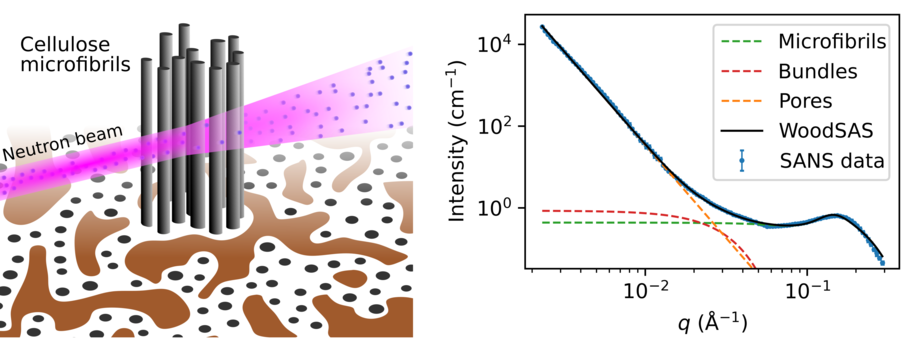
This postdoc project, mainly funded by Emil Aaltonen foundation (2017-2018), developed small-angle scattering data analysis for wood samples. It resulted in the freely-available WoodSAS model, which can be used to analyse small-angle neutron and X-ray scattering (SANS, SAXS) data from wood.
Related publications
- Small-angle scattering model for efficient characterization of wood nanostructure and moisture behaviour, Penttilä, P.A., Rautkari, L., Österberg, M., & Schweins, R., Journal of Applied Crystallography 52, 369-377 (2019).
- Bundling of cellulose microfibrils in native and polyethylene glycol-containing wood cell walls revealed by small-angle neutron scattering, Penttilä, P.A., Altgen, M., Awais, M., Österberg, M., Rautkari, L., & Schweins, R., Scientific Reports 10, 20844 (2020)
Members

Academy of Finland Research Fellow Paavo Penttilä
Dr. Penttilä graduated with a PhD from the University of Helsinki, Department of Physics in 2013, with a specialization in X-ray and neutron scattering. After spending in total four years as a postdoc at Kyoto University (Japan) and the Institut Laue-Langevin (France), he started as a postdoc at Aalto University in 2018. The Academy of Finland granted him Postdoctoral Researcher funding for 2018-2021, and then Research Fellow funding for 2021-2026. Dr. Penttilä holds the Title of Docent in Experimental Materials Physics, awarded by the University of Helsinki.
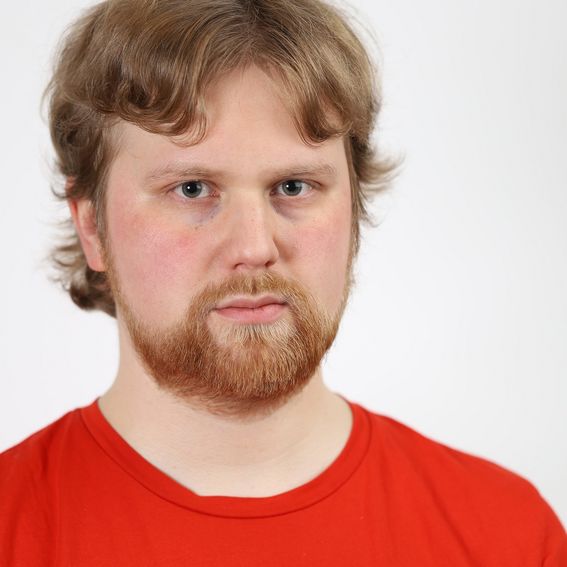
Postdoctoral Researcher Patrik Ahvenainen
I studied computational and materials physics at the University of Helsinki, Department of Physics. I received my doctoral degree in 2016, focusing on studying wood and other plant materials with X-ray methods. After graduating, I received a two-year post-doctoral research grant from Kone Foundation for studying wood used in electric guitars. Before joining Aalto, I worked three years as a 3D Imaging Specialist at Planmeca where I developed algorithms for 3D reconstruction and image processing for dental and medical imaging devices. I joined Paavo Penttilä's research group in September of 2022 to continue my research on wood and other lignocellulosic materials.
Postdoctoral Researcher Tomoko Kuribayashi
I am a postdoctoral researcher involved in the WoodCensus project. My scientific expertise is in structural and mechanical property analysis of cellulose or lignocellulosic materials. In WoodCensus, I work on structural analysis using a transmission electron microscope and electron tomography techniques.

Doctoral Candidate Aleksi Zitting
I received my Master's degree in Physics from the University of Helsinki on molecular dynamics (MD) simulations of damage formation in fusion reactor materials in 2019. Starting from December 2019, I have been investigating wood-water interactions with scattering experiments and MD models, as a Doctoral Candidate concentrating on the experimental side of the SASAMIS project. The current focus of my studies is determining the nature of nanoscale structural changes due to moisture in wood cell walls using X-ray and neutron scattering.

Doctoral Candidate Enriqueta Noriega Benitez
I studied space physics, including solar particle detection and simulations of such particles, at the University of Turku, where I received my Master's degree in Chemical and Physical Sciences in 2021. In February of 2022, I joined Paavo Penttilä’s research group at Aalto University in which we probe the structure of bio-based materials, chiefly wood, through the use of X-ray scattering techniques and machine learning algorithms. Currently, my work in the NNxWOOD project focusses on processing X-ray scattering data with an AI-based approach to analyze the nanostructure of wood.

Doctoral Candidate Cui Yin
I graduated with a Master's degree in Physical Chemistry from China University of Mining and Technology, where I specialized in chemical reaction kinetics. In August 2024, I began my research as a doctoral candidate in the Biobased Materials Structure group. My project focuses on small-angle scattering analysis of cellulose fibers and their interactions with moisture. I am conducting specific analyses of the scattering contributions from different structural components in pulp fibers and developing methods to interpret small-angle scattering data from these cellulosic materials.

Master's thesis worker Janita Makkonen
I study materials science in Aalto University, majoring in Functional Materials. Previously, I studied chemical engineering and environmental technology in LUT University, where I received my Bachelor´s degree. I joined the Biobased Materials Structure group in January 2024 as Master’s thesis worker, and I am currently working in the SmartRecovery project, concentrating on lignin characterization with different light scattering techniques.

How to join us?
Highly motivated MSc, doctoral or postdoctoral students interested in joining the group can contact Dr. Paavo Penttilä ([email protected]).
Teaching
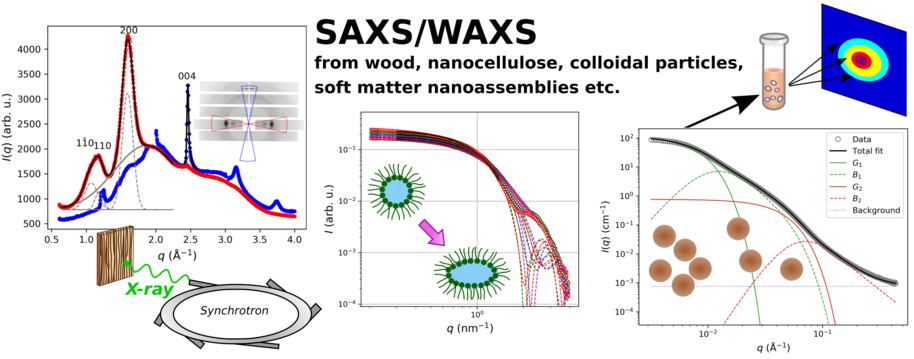
Dr. Penttilä teaches the course “X-ray scattering methods for structural analysis of bio-based materials”, organised next time in April/May 2025. The target of the course is to introduce doctoral and advanced Master’s students to X-ray-based structural characterization methods (both in theory and in practice) and initiate the application of these methods in the students’ own research.
Collaborators
Our group has ongoing collaborations with researchers from Aalto University (Finland), VTT Technical Research Centre of Finland (Finland), University of Helsinki (Finland), Institut Laue‒Langevin (France), Kyoto University (Japan), MAX IV Laboratory (Sweden), and Technical University of Munich (Germany).
Latest publications
Insights into the action of phylogenetically diverse microbial expansins on the structure of cellulose microfibrils
Review: interaction of water vapour with wood and other hygro-responsive materials
Self-assembly of mixed-linkage glucan hydrogels formed following EG16 digestion
Critical comment on the assumptions leading to 24-chain microfibrils in wood
Deaggregation of cellulose macrofibrils and its effect on bound water
X-ray Scattering Analysis of Wood Aided by Machine Learning
The human factor: results of a small-angle scattering data analysis round robin
Degradation of cellulose polymorphs into glucose by HCl gas with simultaneous suppression of oxidative discoloration
Impact of hemicelluloses and crystal size on X-ray scattering from atomistic models of cellulose microfibrils
Moisture imbibition in wood studied by time-resolved X-ray scattering
- Published:
- Updated:




